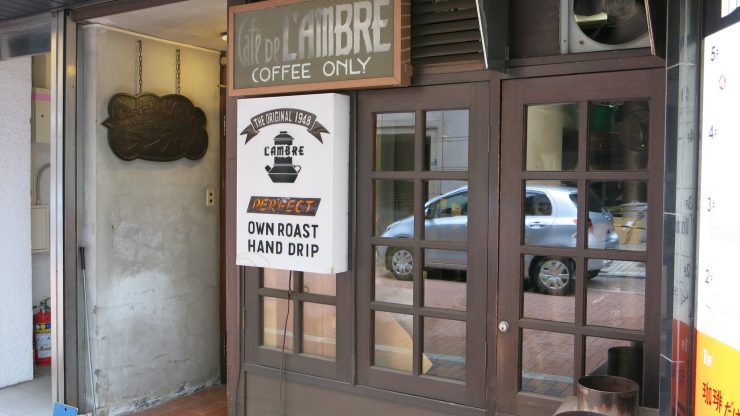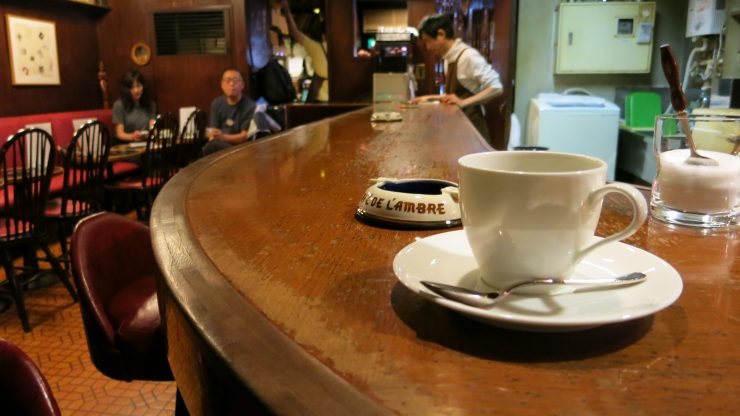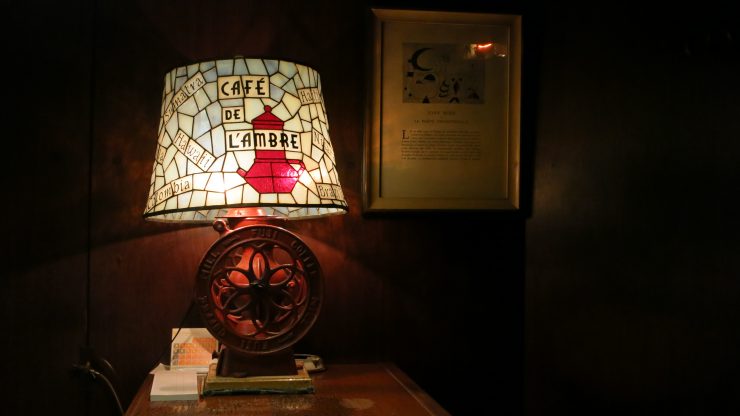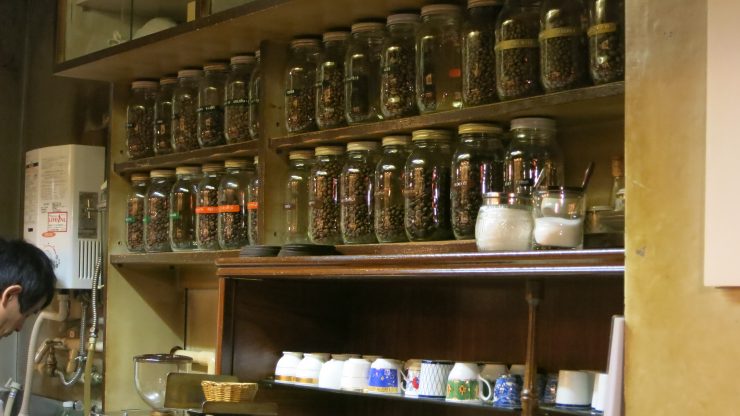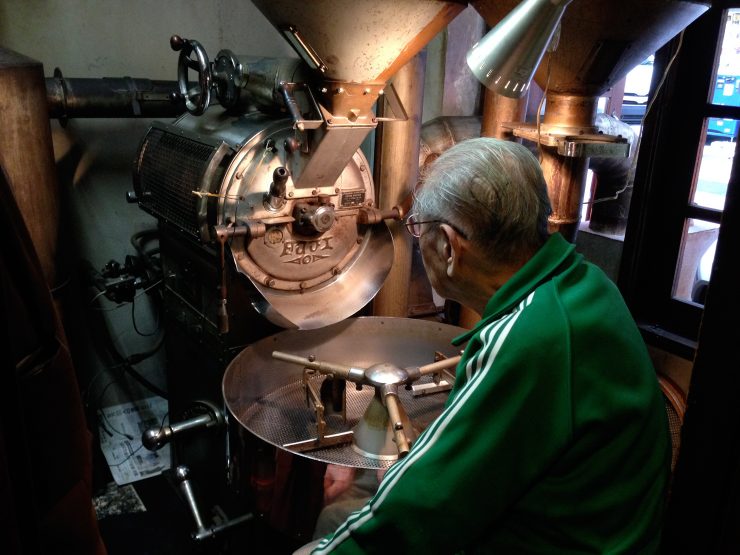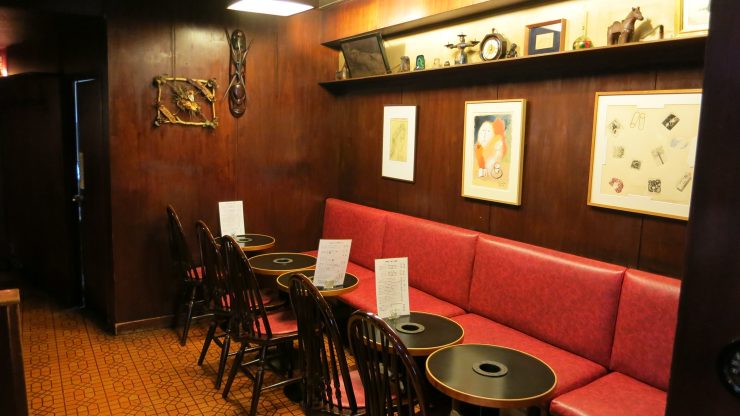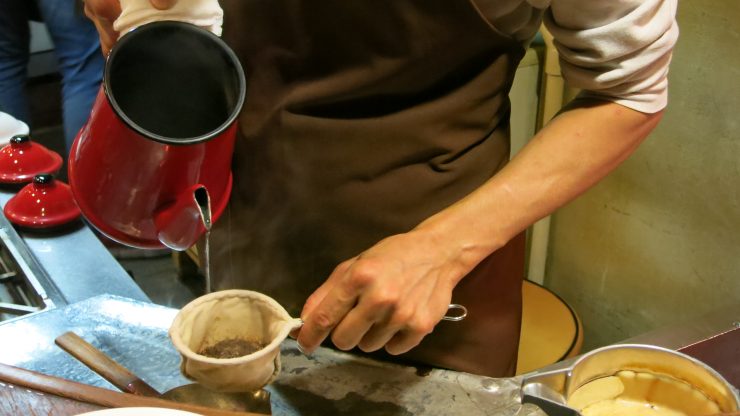On my first trip to L’Ambre, I was early and it was closed. I looked at the little storefront with its window peeking in on the classic Fuji roaster, behind a vintage door and a sign that read, “Perfect own roast hand drip”. I looked around the alleyway it calls home, and the salarymen smoking behind the bank that sits opposite the cafe.
It was a warm, early autumn day, so I wandered the main strip of Ginza, soaking up the blend of classic and contemporary. I marveled at the way department stores and fashion brands rub shoulders with old restaurants, old cafes, and old sweet shops. It was like little pockets of history hiding in the cracks. Tokyo may forever be in a state of constant change, but some parts, it seems, will never change.
When I finally entered L’Ambre, I took a seat at the counter. I stared at the extensive menu for a long time. Eventually I ordered a coffee from Guatemala. It was 790 Yen.
I remember feeling like time was different. Warped somehow. Perhaps it was the absence of windows; it felt like evening inside. And except for the young guy in the yellow t-shirt hefting boxes into the cafe, I got the sense I’d slipped back in time. It was a place, and a feel, that I thought I’d never know as well as the old man in the corner, smoking cigarettes, reading the newspaper, and drinking coffee.
I sipped at the Guatemala when it came, and stared into the black pool as I thought.
I scribbled in my notebook, “Is this what history tastes like?”
Café de L’Ambre first opened its doors in 1948. It moved locations in the ’70s, but has always called Ginza home. Perhaps you’ve heard the stories before—the coffee-only menu, the aged beans that go back decades, the insistence on nel drip. All of it the way it always was, the way it’s always been.
Think about that for a second; that you might be drinking coffee from some 67 years ago.
Isn’t that something?
When I next went to L’Ambre, I wanted to know a little more. I sat at the same swivel stool by the counter, and ordered a coffee. I sipped at it as I worked up some courage. I didn’t know if it was okay to ask about the shop. I stared at the mason jars filled with old coffee, and the people who came and went. Eventually, I began talking to the man behind the counter, and scribbled things in my notebook. He regarded me with something of a bemused half-smile—this foreigner with his broken Japanese and a struggling coffee vocabulary.
In hindsight, I saw it like a scene from a Bill & Ted movie. “I write for a bodacious coffee website in the future,” I saw myself saying. “Coffee is like, really cool right now.”
The man told me they were roasting today. He said Sekiguchi still did it. He said Sekiguchi turned a hundred that year.
Think about that for a second. Really think about it. That you might be drinking coffee roasted by someone who has lived a century. A hundred years. It seems ridiculous somehow, impossible.
And yet, there he was. There was some talking, and some shuffling, and then an old man hobbled out from a tiny office. Ichiro Sekiguchi. He wore a green tracksuit jacket—it looked like Adidas—and a neat pair of slacks. It seemed to break the harmony of the location, but also made sense. It was silly of me to expect the suspenders, the bow-tie, the old tobacco pipe.
Sekiguchi made his way into the roasting room with a younger man by the name of Uchida. There was just barely enough room for the two of them. I hovered by the entrance, and peaked in. They poured some beans into the Fuji, turned a valve, and got the roast started. Sekiguchi watched the beans spinning, then glanced at the thermometer, before settling his gaze somewhere off in the distance.
He told me he couldn’t remember when he started roasting. When I asked him how his career began, he simply said, “sa…” which means a few different things, but in this case was his succinct way of saying, “I don’t much feel like talking right now.” Then he added, “I guess I just wanted to drink a good cup of coffee.”
The wonderfully retro ’90s L’Ambre website sheds some more light. It seems Sekiguchi served coffee at his first job—a cinema machinery gig—and people liked it. Enough that they asked him to start a place in Ginza because there wasn’t any good coffee. So he did. One day, he stumbled across old beans, and roasted them on a whim. The shock of the flavor started his experiments with bean aging. This research is an ongoing project.
I watched the coffee spin, and darken, and I wondered what happens to thoughts and memories when you have a hundred years worth of them. Sekiguchi stared blankly at the old Fuji roaster, and I wondered what he was thinking. I watched him pour some beans onto a mesh net and compare them with a slightly older batch. When they were ready, he let the beans fall into the cooling bed, and spun them around by hand.
I left him there, then. I’d been enough of a nuisance for one day. I went back to my spot at the corner.
I thought about writing everything down in my notebook, but instead I closed it, and left. Outside of L’Ambre, Ginza—and Tokyo—was as it always is: the trains, the department stores, the subways, and fashion outlets. They’re all places and things we’ve seen before. We know what every Starbucks store is going to look like before we step inside. Same with fast food restaurants, convenience stores. Funny sometimes to think that the future doesn’t offer any surprises.
And perhaps that’s the appeal of L’Ambre. Not whether the aged beans are more delicious or not, or if the roast and the extraction are, as the sign says, perfect. Instead, it’s that sometimes, to find a refreshing, original moment in the world of the future, we have to take a step back into the past.
So I hope that L’Ambre never changes. And I hope that whoever picks up the reins after Sekiguchi is gone runs things exactly the same way until he or she is one hundred too. Because a history that you can feel, touch, experience, and taste? This is something worth preserving.
Café de L’Ambre is located at 8 Chome-10-15 Ginza, Tokyo.
Hengtee Lim (@Hent03) is a Sprudge.com staff writer based in Tokyo. Read more Hengtee Lim on Sprudge.
The post In Tokyo, Roasting Coffee Masterfully At Age One Hundred appeared first on Sprudge.


